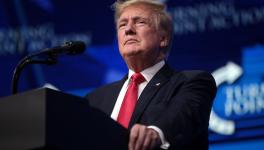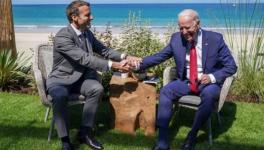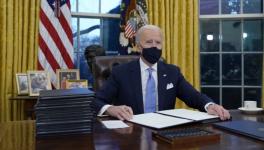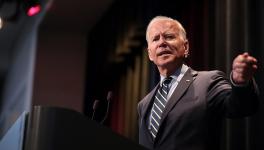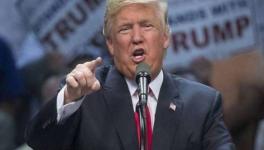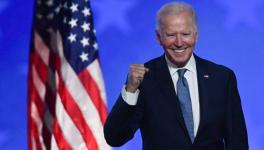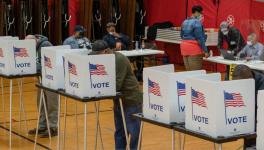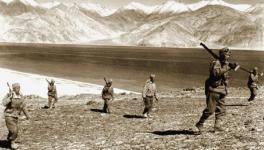Smoke and Mirrors of Liberal Imperialism: Reception of Cold War Against China Among Indian Elite
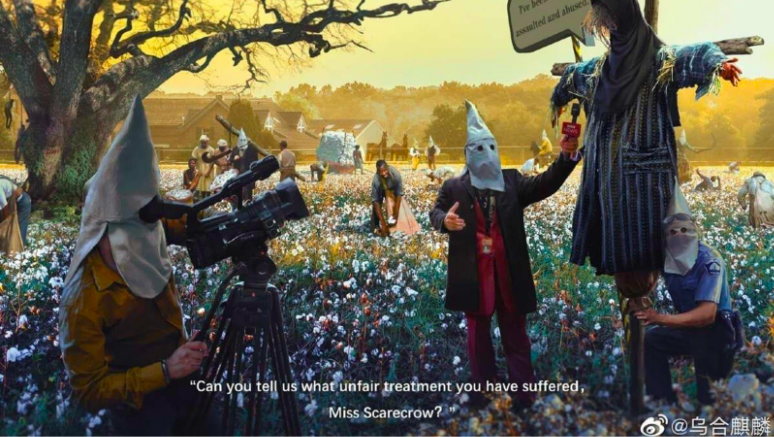
Donald Trump made an interesting claim during his last address as the US President. While listing his achievements he claimed to be “the first President in decades who has started no new wars”, and was “especially proud of it”.
It is indeed true that he had sought no new authorisation from the Congress to use military force outside, as is required under the American law. But all military actions started by his predecessors in Afghanistan, Iraq, and Syria had continued under his watch. His anti-Iran Zionist passion had brought the Middle East to the brink of conflagration after American forces in Iraq murdered Iranian general Qasem Soleimani.
However, since Trump’s presidency did not see aggressions at the scale seen in Korea, Vietnam, Grenada, Panama, Iraq, Yugoslavia, Afghanistan or Libya initiated by other presidents, he may not be too much off the mark. If nothing else, his claim does underscore how important wars on other countries are to the self-imagination of the US establishment. The US spends more on its armed forces than the total money spent by eight other largest spenders together. Its nearest rival, China spends only one third. Russia, which has the second most extensive military-industrial complex after the US, spends 10 times less on its armed forces.
Agent Orange, My Lai, Abu Gharib, or Guantanamo Bay, are some of the more disgusting faces of the remorseless violence of US Armed Forces against people of the other countries. However, looking only at the US and its military actions gives only a limited, and actually a misleading picture of the liberal imperialism that dominates the world today.
Most closely allied with the US are the four other Anglophone countries, the UK, Canada, Australia and New Zealand. All have their roots going back to the British colonial empire. All the four settler colonies in this group came about after complete and forcible disintegration of indigenous communities, often amounting to genocide. Besides a common language and culture, they also share similar social institutional and ideological orientation.
While political conservatism has remained strong internally, arrogance of being part of an empire, first the British, and then the American, and smugness of liberalism has meant that the labour politics could not develop a radical current in any of them. All share a common sense of imperial superiority. Armed aggression against other people is considered a natural right. Even small New Zealand, which appears progressive in its internal policies, has had no compunction sending troops to Vietnam and Afghanistan.
These countries form the so called Five Eyes alliance, which is the largest network of intelligence gathering and espionage in the world. They have divided the world among themselves for gathering intelligence on countries, their governments, individuals and organisations. Edward Snowden’s leaks had for the first time thrown light on the dirty work of this alliance. Planting spyware on computers and communication devices the world over are routine. An interesting practice is outsourcing of spying and espionage on their own citizens to other members of the alliance. Hence, New Zealand and Canadian agencies would spy on British citizens, and vice versa.
Also read: US’s China Policy at Inflection Point
The next ring of liberal imperial order is made of the core countries of Europe, Germany, France, and long standing vassals of the US in Asia, namely Japan and South Korea. These countries have participated in coordinated military actions in other countries. The US Armed Forces are permanently stationed in Germany, Japan and South Korea. Operational plans of their armed forces are aligned with US Armed Forces.
The core countries of the imperial order which have about 8% of the world’s population, produce more than 45% of the world’s GDP. They have the most advanced technologies. Many commentators who compare only the US with China, and looking at the Chinese economy overtaking the US in near future anticipate a changed world order, miss this point. China is not just up against the US, but an imperial system whose economy is nearly double its own. It will be not years, but many decades before it can hope to catch up, and the current imperial order is in no mood to let that happen peacefully.
The Liberal Imperial Net
Liberal imperialism justifies domination over other countries in the name of liberal values. Hence, ideologues like Edmund Burke, and James and John Stuart Mill in the early 19th century argued for the British rule in India in terms of social reform of the native society. Governor-General (later Viceroy) Bentinck’s abolition of sati was an early experiment of colonial power motivated by liberal reform.
Protection of human rights by the ‘international community’ has emerged as the most potent declared goal of imperial interventions in the twenty first century. Critical studies have analysed how western governments, media, humanitarian NGOs, and public intellectuals have drummed up support for armed interventions to supposedly save people from despots and violent overlords in selected target countries. Iraq, Yugoslavia, Sudan, Somalia, Libya, Syria or Afghanistan were not mere military adventures, but also well thought out ideological campaigns in which the human rights discourse was strategically used to advance western imperial interests.
Liberal imperialism of the 21st century is a complex project with interlinked economic/financial, political, ideological, and cultural domains. Use of armed power to enforce its writ is only one part of it. While the US is the overwhelming centre, the strength of liberal imperial order comes from it being a network of close allies. It would not be half as powerful were it not for these other pegs of the imperial order. Further, it is necessary to appreciate the de-territorial character of liberal imperialism without which its non-colonial political character, and ideological and cultural domination over the world cannot be understood.
An open network form of its internal relations and the fetishisation of human rights are the two prongs of liberal imperialism. The former makes it dynamic and is a source of its internal strength. The latter is the basis of its popular appeal, not only among the people of the dominant countries, but also among elite sections of dominated societies. Its network form helps to distinguish it from earlier forms of empires, both pre-colonial and colonial which emanated from clear institutional and geographical centres of power.
Liberal imperialism is characterised by alliances in which every participant feels to be an autonomous agent. The New Zealand Prime Minister knows what is expected of her in the game. She fulfills her role not at the diktat of the US President, but as an agent who seemingly has a ‘choice’. The network epithet also explains synergies between different domains of the imperial order. There is no ‘central committee’ passing orders, yet it is no accident, nor a conspiracy that at the same time as economic sanctions and armed aggression against a country get tightened, media giants like Reuters, BBC, Associated Press, New York Times, DW, etc., simultaneously go ballistic over ‘evil’ deeds of targeted rulers. This was so over the so called ‘weapons of mass destruction’ of Saddam Hussein (which later proved to be products of imaginative lies of western rulers) in 2003, or is now over the supposed ‘genocide’ of Uighurs in the Xinjiang province of China.
Charms of Liberal Imperialism and Third World Elites
The fact remains that despite a history of obfuscations, selective leaks, and outright lies by diplomats and media of liberal democracies, their stories about violations of human rights in other countries, and justifications of armed aggression still sell. Nowhere is this more apparent than among the elites of third world societies.
The coverage of the recent conflict between liberal imperialism and China in Indian English language media is a case in point. It is immediately obvious that almost all news reports whether about ‘forced birth control on Uighurs’, ‘Chinese hackers spying on Uighur activists’, or ‘detention camps for Uighur Muslims’ are republications of reports from Western media outlets like AP, Reuters, or NYT. Even columns that try to ‘explain’ what is going on with Uighurs are commentaries based entirely on one or two publications in the Western media. In fact, a lot of critical commentary and analysis on the coverage of the issue by the Western media is readily available in social media and internet. These, however, do not find any place in Indian media.
Also read: Myth of Internationalisation of Democracy
In particular, Canadian researcher and journalist Ajit Singh has written extensively on many ‘expert’ reports on Xinjiang which have been periodically coming lately from Western think tanks. Most of these institutions are associated with Western countries’ strategic interests, and/or are funded by their defence industry. A German ‘expert’ Adrian Zainz quoted in most reports is also associated with Christian fundamentalist and anti-Communist organisations. His initial claim of one million Uighurs in camps was based solely upon a report in a TV channel of an Uighur exile organisation based in Turkey.
Western reports on Uighurs often use Chinese media reports not just for quoting or information, but also to authenticate their claims by selective pickings. An Australian report about forced labour of Uighurs presents a Chinese media report on an Uighur worker at a central Chinese province as evidence for ‘little freedom of movement’ and ‘isolation from family’. According to Singh, however, the original report has a different tone. While it does highlight challenges of working away from one’s family and province, it also claims that the worker wants to work for more duration to save more money. A recent BBC ‘investigative report’ recommended in the web portal Scroll.in about forced migration of young Uighur workers has similarly been accused of selectively using clippings from a 2017 Chinese media report.
Reasoned argument, neutrality, authenticating sources, giving space to contrary views are some of the virtues which the liberal Western media claims for itself. However, the form these virtues take, particularly regarding issues in which imperialism is invested, is revealing. Almost all news reports on Xinjiang also state that the Chinese government contests claims of genocide in the province. The information appears as a perfunctory add-on, and the Chinese government’s claim are presented merely as claims. Arguments of the Chinese and the evidence they present in support of their claim find no mention. The form of presentation is implicitly driven by and in return supports the assumption that only the Western narrative is supported by evidence and argument. Counter narratives are only claims. This ‘othering’ (they are fundamentally different from us) continues the longstanding orientalist tradition of the Western view of the rest of the world.
De-subjectification of the Other is another orientalist trait shared by liberal imperialism. One consequence is the failure to engage with the critical gaze of the other. It is not only that the imperial subject looks at others. Others too look at imperialism and express their counter view.
Also read: Why Biden Will Keep the US-imposed Cold War Rolling
A Reuters report put up in the Indian news portal LiveWire illustrates the point. The report is titled ‘Chinese Digital Art Mocks Western Criticism of Labour Conditions in Xinjiang’ and is about a digital poster gone viral in the Chinese social media. The report is only a description of what is seen in the poster. That the poster is framing the persistent racism in the West with the calls to boycott of Xinjiang cotton is entirely missed.
Black slaves on cotton fields, white hoods of Ku Klux Klan, and the ongoing police violence against Blacks in the US are all there in the background of a media microphone seeking answers from a scarecrow. But the report does not get the racism part. It even misses the association of white hoods with the KKK. It is mentioned that the artist had earlier made a digital poster showing Australian soldiers with a bloodied knife on the throat of an Afghanistan child, which had drawn ‘fury of the Australian PM’. This comment, however, comes without any mention of the context of the earlier poster.
In November 2020, an enquiry on war crimes by Australian soldiers in Afghanistan had found that 39 civilians were illegally killed by commandos of elite Australian units. It also referred to an earlier 2016 enquiry, according to which Australian soldiers had slit throats of two 14-year-old Afghan boys. So, the artist was not making things up. If anything, the ‘fury’ of the Australian PM was most likely made up for an effect.
It is interesting that even when Western lies and crimes are noted, for example about Iraqi weapons of mass destruction, or war crimes of Australian soldiers in Afghanistan, a scrupulous silence is maintained about non-Western voices against such lies and crimes. It may be admitted that a Tony Blair or a George Bush told a lie, yet a Saddam Hussein saying that these gentlemen leaders of the West are liars, will not be noted. That would fracture the carefully crafted moral superiority of imperialist subjectivity. Even the criticism of such a subjectivity can at best be self-referential. The humility of seeing oneself from others’ perspective is an implicit taboo.
Liberal imperialism remains orientalist at its ideological core. This, however, does not explain its sway over third world elites. Part of the reason for the latter is precisely the liberal character of this form of imperialism. Its open form allows cultural integration to occur at various levels, from kids’ cartoons to academia. The liberal network is formally non-identitarian, yet is also flexible to allow for an identity based incorporation. The liberal individuation of human subject comes with the promise of moral autonomy. However, realising this promise in a complex world, in which economic and political power is a means to exploitation and oppression, is not only onerous but also full of risk.
Participation in the humanitarian claims of liberal imperialism provides a short cut to a ready made morality. It gives the satisfaction of fighting against injustice and helping others at little cost. In a way, it is fun to rally against tin-pot dictators in far away countries. Organising against one’s own elected governments is frustrating and risky. Worried about pictures of famine in Africa! It is much more easy to participate in ‘Live Aid’ music concerts, than to question the political economy of agribusiness. The ultimate seduction of liberalism is its guaranteed delivery of self-love on the cheap. American folksinger Phil Ochs’ satirical punch ‘Love me, Love me, I am a Liberal’ remains the best description this self-love. And that works for third world elites as well.
(The author teaches Physics at St Stephen’s College, Delhi. The views are personal.
Get the latest reports & analysis with people's perspective on Protests, movements & deep analytical videos, discussions of the current affairs in your Telegram app. Subscribe to NewsClick's Telegram channel & get Real-Time updates on stories, as they get published on our website.









